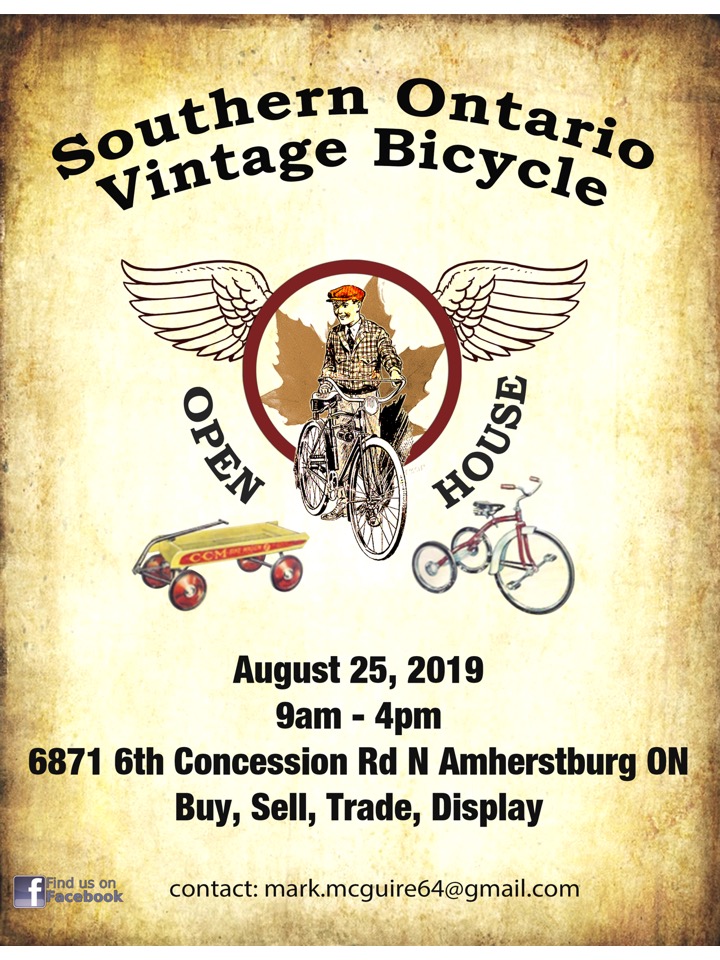Archives
YOU ARE INVITED TO THE ANNUAL XMAS SOCIAL
SUNDAY, DEC. 1, 2019
(PLEASE PRAY FOR GOOD WEATHER AS THERE IS NO BACK-UP DATE THIS YEAR)
TO BE HOSTED for THE WHEELMEN in CANADA
By
Captain Roger Tupper
TO BE HELD AT THE HOME OF THE MILTON HISTORICAL SOCIETY
WALDIE'S BLACKSMITH SHOP
16 JAMES ST.
MILTON, ON L9T 2 P4
905-875-4156
www.miltonhistoricalsociety.ca
INCLUDES A PRESENTATION
SCHEDULE
12:00 - DOORS OPEN. Please be there by at least 12:15
12:00 to 12:30 - MEET & GREET + getting the kitchen & tables organized.
12:30 to 1:30 - LUNCHEON and clean up
1:45 to 2:15 - SOCIAL + SHOW & TELL. Bring something new or old to show and
share. Chat and plan. Special meeting of the Liars Club to be held in the Grand Ballroom.
2:15 to 3:00 - SWAP MEET ~ BRING YOUR JUNQUE or TREASURES TO BUY, SELL or
TRADE. Bikes, Trikes, Ephemera, Parts, Accessories, Tools & Memorabilia
etc.
3:00 to 4:00 - OUR PRESENTATION
FOOD & BEVERAGES:
* PLEASE BRING A FOOD ITEM TO SHARE.
* ALCHOHOLIC BEVERAGES may NOT be consumed or brought into building.
* COFFEE & TEA will be supplied. If you wish sodas, fruit juice,
colas or whatever, please bring your own.
* SPECIAL FOOD REQUIREMENTS OR FOOD ALLERGIES ~ Please advise in advance.
SPECIAL NOTES:
* Our cost to rent the venue is $20 per hour. Our estimate is that at least 15 people will attend. Consequently we need to charge a "help pay for the rent" fee of $7.00 per person.
* Bring friends or family members. This is a great time to get involved. Everyone is invited. Why not bring a future nonmember of The Wheelman whom you might know? He/She might like to join. The more the merrier.
IMPORTANT
Please be so kind as to R.S.V.P. by Nov. 5th (however, the earlier the better). That would be much appreciated.
Kindly reply to: lorne-shields@rogers.com or leave a phone message at 905-886-6911
Best wishes,
Lorne Shields
COMMUNICATIONS
THE WHEELMEN in CANADA
Phone: 905 - 886 - 6911 (WITH Message taking capability)
Cellular: 416 - 568 - 5495 (NO Message taking capability)


The advent of the First World War (1914 - 1918) saw many battalions on bicycles rather than horses. Equipped in the same manner as the horse with a bed roll on the front and a rifle slung on its side, the bicycle was used by scouts, messengers, infantry men and even ambulance carriers.
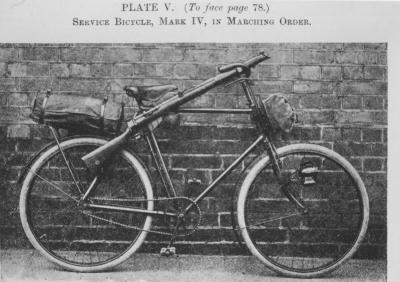
At the outset of the war as the 1st Canadian Division began training at Valcartier, Quebec, it was decided that a cycle unit should be formed to carry out intelligence work with the Canadian Expeditionary Force. So it was that the 1st Canadian Cyclist Company sailed for England with the 1st Canadian Division on October 14 1914. Cyclist companies were also formed with the 2nd, 3rd and 4th Divisions and in May 1916 all four Divisional Cyclist companies were merged into the "Canadian Corps Cyclist Battalion."
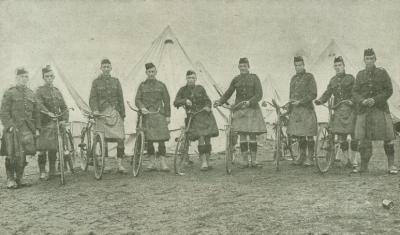
Canadian Cyclist Corps. camped on Salisbury Plain 1914
Once in England the cyclists were trained in musketry and bayonet fighting, as well as signaling and topographical techniques. They carried out traffic control, sapping and mining, and served as trench guides, listening posts and battalion runners as well as dispatchers. Despite being hampered by the terrain and muddy conditions, bicycles were used to transport men and supplies over large distances and were said to be able to cover over 60 kms a day.

Allied cyclist scouts walking their bikes in the mud of war-torn France.
With a casualty rate of over twenty per cent, the bicycle corps. became known as a "suicide battalion" or "Gas Pipe Cavalry." One of the hardest hit units was the Newfoundland Regiment ninety per cent of whom were killed or injured at Beaumont - Hamel. Because of their courage, King George V gave the regiment the prefix "Royal" - the only time during the first World War that this honour was given.

The Newfoundland Regiment marching with their bicycles back to billet.
The individual responsible for supplying the Canadian military with bicycles was none other than Tommy Russell, general manager and soon to be president of CCM. Following a meeting on August 14, 1914, with the Minister of Militia and Defense, Colonel Sam Hughes , Russell was made an honourary Major and named purchasing agent for the Canadian Expeditionary Forces.

Demobilization begins as cyclists cross into Cologne.
A Canadian cyclist was the first Allied soldier to cross the Bonn bridge into Germany following the Armistice of November 1918.

Check out the photos: https://www.facebook.com/Southern-Ontario-Vintage-Bicycle-Open-House-540007036052649/

Like many nineteenth-century industrialists, Henry Abrahm Lozier started out selling sewing machines before turning his attention to bicycles. Based in Cleveland, Ohio, in 1891 Lozier bought a sewing machine factory in nearby Toledo for the purpose of manufacturing his "Cleveland" bIcycles. With his cycles quickly becoming known for their high quality, within a few years Lozier was among America's top bicycle makers, along with Augustus Pope (Columbia) and Victor Overman of the Western Wheel Works.
In 1895 Lozier established a branch plant in Canada on Weston Road in what was then known as the Toronto Junction. In charge of the plant was Lozier's brother-in-law Edwin R. Thomas. (When Lozier eventually sold his Canadian operation in 1899 to Canada Cycle & Motor, Thomas, who went on to develop the Thomas Flyer motor car, would become a director of Canada Cycle & Motor).

Claiming that their Cleveland bicycle was the finest bicycle that "money and brains" could produce, from the outset Thomas and H.A. Lozier & Co. were eager to lay down roots in their newly-adopted home.
We now issue our first catalogue to the Canadian public, and with pardonable pride we allude to the fact that, independent of the whole world, Canada now has a bicycle each piece and part of which is manufactured within the limits of its territory, by labour of its own, being distinctly Canadian, in fact the counterpart in every detail of wheels of the same name manufactured in the States, the reputation which is world-wide and popularity equaled by any bicycle.
Around the World on a CLeveland Bicycle, H.A. Lozier & Co. Ltd. Toronto, 1896
By the fall of 1896 the Lozier company was displaying its bicycles in the Carriage Building at the Toronto Industrial Exhibition (later the CNE) and had opened a riding school in Toronto's Granite Rink.
Below is an article written by a reporter from The Globe following a visit in April of 1896 to the Lozier factory at Toronto Junction.
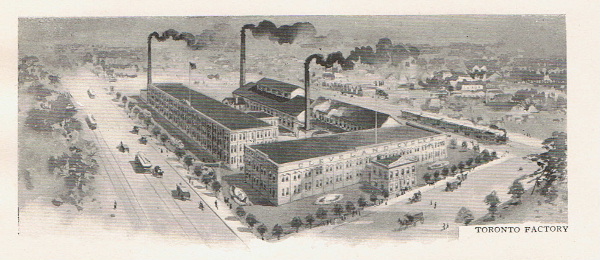
MAKING BICYCLES
An Interesting Visit to the Lozier Company's Factory.
WONDERFUL MACHINERY
Defective Workmanship an Utter Impossibility
Superiority of Canadian Artisans - Strictly High Grade, Regardless of Cost, the Motto - A Boon to the Junction.
Amongst the many thousand bicyclists who, now that the wheeling season has arrived, are to be seen daily gliding along the streets and out in the suburbs of the city, there are few, if any, who give even a thought to what the production of one of these "noiseless steeds" costs. Pleased as they are with the speed, ease and grace with which they cover distance, their curiousity is swallowed up in satisfaction. They do not bother themselves in estimating the amount of brain energy necessary in making the close calculations required in the construction of these delicately fitted machines, nor do they trouble their minds with questions regarding the vast outlay of capital indispensable to a factory where a strictly first-class bicycle is manufactured. One reason for this is that probably not one in every thousand has ever seen the inside of a bicycle factory, "absolutely no admittance" being the rule enforced in nearly every establishment of the kind on the continent.
On one of the beautiful days of this week a representative of The Globe wheeled out to the Junction, and having heard the praises of the Clevelnad bicycle loudly sung on all sides, having been informed, too, that that establishment was employing 400 hands, and paying out very heavy sums in wages every month, he determined to avail himself of the opportunity of going over the institution, the Cleveland Company, contrary to the usual custom, being desirous that all who wish to do so should inspect their factory. This was a chance not to be lost of seeing a bicycle made from start to finish.
Arriving at the factory, which is just on the eastern outskirts of the town, the first person met was the active and energetic resident partner and General Manager, Mr. E.R. Thomas, who was in the act of issuing passes to several others bent on the same errand as the reporter. Procuring the necessary piece of pasteboard and a guide book, which the company has had printed for the convenience of those visiting the works, the visitors passed into the main factory building. This is divided into several departments, each one occupied to its fullest capacity with busy workers, and replete with the most modern and expensive machinery known in the art of bicycle construction, the cost of the plant and machinery alone in this factory being over $200,000.
Proceeding to the forging department, where the heavy thud of the ponderous drop-hammers and the roar of the oil furnaces produced a noise that was almost deafening, the first operations on the forged parts was seen. Here in the hands of deft and skilled mechanics the heavy solid steel bars, after being heated with the oil process , which has a toughening tendency, are beaten into the shape of sprockets, cranks, etc. Here is also seen the interesting process of braxing joints, all tempering ball cups, cones, chain blocks etc. The cranks are also tempered here, but undergo a different process, being first heated in molten lead and then immersed in a secret chemical solution of equalizing temperature.
In the next department some of the most wonderful machinery ever invented for the working of steel was seen in operation. Most of it is automatic in its operation, and some of it almost human. It is devoted to drilling crank hangers from solid steel forgings, profiling fork crown forgings and sprocket arms, milling chain blocks and sprockets, rolling handle bars, aluminum rims and blocks, and many other operations too numerous to mention. It is here where one gets the first idea of the enormous difference in the expense attending the manufacture of a strictly first-class wheel and one not up to that standard. Tools out of the best steel have to be graduated to as low as one-thousnadth of an inch, and on account of the accuracy required they have to be constantly renewed. It requires a very high order of intelligence to become a first-class toolmaker, and consequently high wages are paid. In the manufacture of the Clevelnad bicycle one toolmaker is employed for every wheel per day turned out, while in other factories, which manufacture cheaper grades, it is aid that one toolmaker is sufficient for every seven cyles produced per day.
Passing on, the many processes necessary to the making of a first-class chain is seen, and here the Cleveland people again spare no expense. After the chain is made it is put on an adjusting jack, which tests the rivets and makes the chain as pliable as a watch chain. The "jack" which is composed of four different-sized sprocket-wheels, revolves at the rate of about 300 revolutions per minute. it has a 1,000-pound weight attached, and a vibration strain of 400 pounds more; and even this severe test is not considered sufficient, because, before the chain is put on the wheel, it is subjected to what is known as a thousand pound jerk test.
The polishing room is another very interesting department, and is said to contain the most complete outfit in Canada. The sand blast system has just been added , which is used for polishing all the lighter parts, and is the only sand blast system in Canada. By this process the original strength of the parts is preserved, and it also does away with the process of "pickling," which is otherwise necessary, but considered by some experts to be injurious to the temper of the steel. Here, again, the firm decision of the management to make only the best, regardless of expense, is seen, as one man could polish more parts by the pickling process than seven can under the sand blast process.
The enamelling department was next inspected and proved most interesting. It contains twelve ovens, heated by oil; the heat is generated by a pressure of air of forty pounds to the square inch. In these ovens the enamel is baked on the parts, which is put on by the dip-tank system, thus insuring an even surface and perfect job. Four operations are necessary before the Cleveland's rich and durable finish is attained. Evidently no expense has been spared in the nickle-plating department, which alone is well worth a visit. It contains, besides the copper and nickle plating tanks, a 3,500-gallon dynamo, operated by a separate power. The reason for this is that it insures the process being kept going continuously, and thus gives ample time to make a good job.
The inspection department was next visited, and proved to be the most interesting of any yet seen, fully bearing out the assertion of the manager that it is "the crowning glory" of the Lozier factory. This is where the splendid reputation which the Cleveland wheel has won is maintained. It is claimed to be the most perfect inspecting department in the world. It is the most costly in the whole establishment, not so much in the wages of the large staff of expert inspectors employed, but in the waste of finished material, for such rigid inspection is almost incredible to those who have not seen it. From five to thirty-eight different operations are required on each part of the Cleveland bicycle. Each part, after each operation, must pass through this department, where it is rigidly guaged and tested upon special apparata.
The following might be given as an illustration - The sprockets are placed upon a fixture that is absolutely accurate as to the length of sprocket-arms, which have been previously tested. The spaces between the sprocket-teeth are guaged by a fixture so regulated by a needle that a deviation of two-thousandths of an inch, which is imperceptible to the eye, shows at the point of the needle a deviation of one-thirty-second of an inch, and causes the sprocket to be rejected as being defective. All cones, which are made of the very best tool steel, must come to a wrench fit. After being hardened by a secret process, they are again tested with a sharp-pointed prick punch, the slightest indentation causing them to be rejected. The inner links of the chain must come to two and one-half-thousandths of an inch, this guage limit being carried out in respect to the work in each department, and it is only those who are familiar with the production of interchangeable work who can form an idea of the enormous cost increase of the limit of variation.
Every part of the Cleveland bicycle, with the exception of the tubing, is made in the factory, by Canadian workmen, who, the Manager claims, are the best on the continent. No expense has been spared in looking after the comfort and health of the men, and each one feels that on him alone, by the exercise of all his talents, depends the success of the Junction's greatest enterprise.
On a fine afternoon no pleasanter or more instructive outing could be found than a visit to this complete factory. The city show-rooms are at 169 Yonge Street, and they have a riding school in connection. This school has been found too small for the large number who dail patronize it, and so the management has leased the Granite Rink for the summer months. This has been fitted up as a first-class riding school, and will be opened to-day.
The Globe, April 18, 1896.
The CVBS 6th Annual Winter Indoor Event went very well considering that the weather system we have been dealing with caused many to stay home.Still we had folks from Amherstburg, Kingston, Barrie, Trenton and many more places make the run to Brantford. This years event as always puts you with like minded people,and we have a great time Wheeling & Dealing. I have to stress again that it starts early and goes hard for 5-6 hrs and then we all pack up. I received some emails about this, as well some did not show until after 1pm.Thx to All who could attend, as we will be able to give the Stedman Community Hospice Brantford 400$.
Not too early to start your plans for our Big event,the CVBS18 2019 Sunday June 23rd, our 13th year at the beautiful Heritage View Farm.Hope to see you there.
Here are a few pics taken early Sunday.Best
Regards Jamie

















A LOOK BACK AT LAST YEAR













Capture of Boer soldiers by cyclists
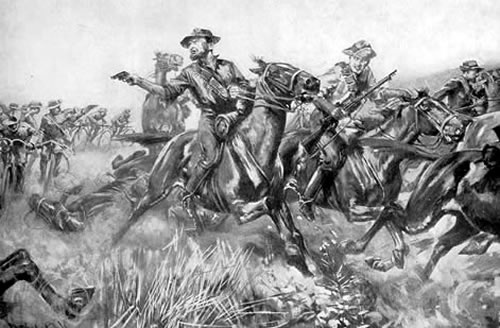
‘Capture of Boers by cyclists near Eerste Fabrieken’.
This somewhat romantic illustration appeared in After Pretoria: the guerilla war, which was published in London in 1902. The author, Herbert Wilson, claimed that this was the only time in the South African War that cyclists chased and captured Boer soldiers.
The cyclists were led by Lieutenant Alexander Wynyard-Joss, ‘Auckland’s favourite mandolinist’, who had moved to Australia before going to South Africa in charge of the 5th Queensland Imperial Bushmen’s cycle section. He described the incident in a letter that was published in a Brisbane newspaper, The Queenslander, on 22 June 1901:
I am pleased to say that I have been personally congratulated by General Plumer for the smart capture of a small Boer convoy, consisting of nine Boers, four waggons, and 160 head of cattle. I took them completely by surprise with eight of the Cycle Company, and had the pleasure of smashing up their rifles and burning all their ammunition, securlng for myself a lovely Mauser carbine and Boer bandoleer full of cartridges.
Although each of the main centres had a volunteer cyclist company by 1898, New Zealand did not send any cycle units to the South African War. It is quite possible that other New Zealanders served in cyclist companies in South Africa, though Wynyard-Joss is the only one we have been able to confirm.
Later in the same letter Wynyard-Joss noted some of the pros and cons of using bicycles in the war:
We have had a terrible lot of horse sickness in the camps, and over 200 have been walking these last few days. This sickness does not attack the bikes, but, oh! the prickles and punctures are awful. The [Massey-Harris] machines I must say have stood well.
Wynward Joss (1872-1954) was born in Scotland but his family probably moved to New Zealand when he was still at school. By 1890 he was competing in cycle races in Christchurch. He then moved to Whanganui, where he taught mandolin and guitar before moving to Auckland and becoming manager of the the Cleveland Cycle Agency about 1898.
In mid-1900 he moved to Brisbane to managed the Cleveland Cycle Agency there. In 1901 he joined Queensland’s 5th Imperial Bushmen Contingent and was appointed officer in charge of the 500-strong cycle section, which arrived in South Africa in early April. He stayed with this unit until May 1902, when he served briefly with the New Zealand 8th Contingent.
By 1914 Wynyard-Joss was manager of the Canada Cycle and Motor Co. Agency, Brisbane. He enlisted for the First World War as a lieutenant in the Austalian Imperial Force’s 301st Mechanical Transport unit. Promoted to major, he was in 1919 awarded an OBE for his war service. In the 1930s he leased Cid Island in the Whitsunday group, north of Mackay. Alexander Wynyard-Joss died in Queensland in 1954.
Credit: H.W. Wilson, After Pretoria: the guerilla war, Amalgamated Press, London, 1902
Courtesy: https://nzhistory.govt.nz/media/photo/capture-boer-soliders-cyclists, (Ministry for Culture and Heritage) 19-Aug-2
Thanks to Jason Hebron for sending us the article.







